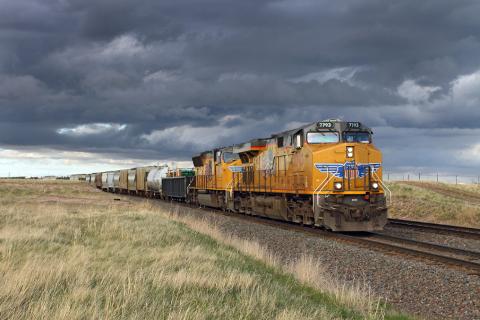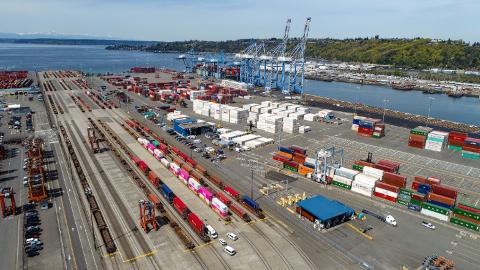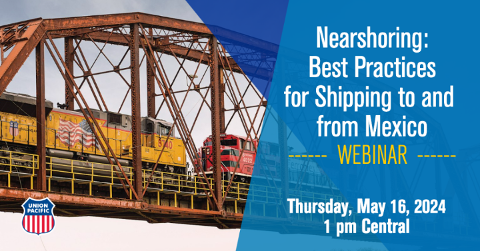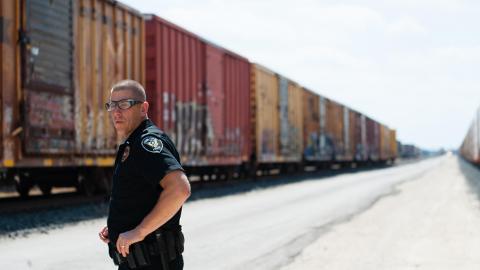In the next three decades, more than 35 billion gallons of sustainable aviation fuel (SAF) will be produced in the United States. It’s part of a government program, called the Sustainable Aviation Fuel (SAF) Grand Challenge, that is designed to help airlines decarbonize. The rise of renewable fuels, including SAF, makes it critical for producers and receivers to have a supply chain in place to meet upcoming fuel demand.
Truck, Vessel or Train: What is the Best Way to Ship Sustainable Aviation Fuel?
While the jet fuel market has historically been well-aligned to ship via pipeline, due to the change in product make up and geographic production density, new solutions are required for the supply chain to be successful.
The SAF production infrastructure focuses on commercially ready conversion technologies and feedstocks. According to the Office of Energy Efficiency and Renewable Energy, an estimated 1 billion dry tons of biomass can be collected sustainably each year in the United States. These resources include fats, oils, greases, and other green energy sources, which serve as feedstocks to make SAF.
These are typically produced in the Midwest by feedstock suppliers, but consumed in other states, so they are shipped by truck, train or vessel. So, which mode of transportation is best for shipping SAF?
Trucks
- Volume: A single tank trailer can haul about 8,000 gallons of fuel, less than a third of a rail car (also referenced here when learning about shipping renewable fuels and feedstocks).
- Transit time: Trucks travel at an average speed of about 50 mph, offering quick delivery for short to medium distances. However, it’s important to note that trucks can be delayed by weather, construction, and roadway congestion.
- Cost: Rates for truck shipping can vary based on availability. In recent years, driver shortages and enforced hours of service requirements have strained capacity, driving spot prices higher.
- Environmental Impact: Trucks are significantly less fuel efficient than trains and contribute to a greater percentage of total greenhouse gas emissions. In fact, if 25% of the truck traffic moving at least 750 miles went by rail instead, annual greenhouse gas emissions would fall by approximately 13.1 million tons. SAF was created as a new fuel source due to its benefits to the environment, and the impact from shipping should be considered along with the product.
- Collaboration with Pipeline Transportation: Pipeline is an ideal option to handle the last mile of transportation after neat SAF and conventional jet fuel have been blended. This blending terminal would ideally be close to an airport so delivery would be a short distance.
Vessel
- Transit: From the Gulf Coast to the West Coast, it takes three to four weeks for a vessel to complete a voyage and deliver fuel to the end market.
- Cost: Costs associated with shipping via vessel have historically made this a positive economic decision, but pricing isn’t as competitive. When shipping via vessel, there are additional fees for a vessel charter and travel through the Panama Canal. Market conditions can also fluctuate on the cost of vessel shipping.
- Other Impacts: As of February 2024, drought is affecting 40% of cargo shipped through the Panama Canal. Operations have been disrupted, reducing the number of vessels per day.
Trains
- Volume: Trains are ideal for shipping large volumes of freight. One train can carry up to three hundred trucks’ worth of product, making it easy to ship large volumes of SAF at a time.
- Transit time: Although trucks are known for offering fast delivery, transit times for rail and over-the-road trucking can be comparable. Trains are not impacted by traffic congestion and road construction delays and can efficiently move shipments over long distances.
- Cost: Rail shipping is considered one of the most cost-effective modes of transportation, especially for large volumes traveling long distances. Due to its ability to move large quantities of freight at a time, rail shipping has a lower cost-per-ton-mile than truck shipping.
- Environmental Impact: Shipping by rail is the most environmentally responsible way to ship fuel or freight by land. Union Pacific can move one ton of freight 444 miles on a single gallon of diesel fuel, generating a carbon footprint up to 75% less than trucks. This makes trains a fitting transportation mode for those seeking to lower their carbon footprint.
How to Ship Sustainable Aviation Fuel by Rail
Because of blending restrictions, SAF cannot be moved directly into an aircraft like conventional jet fuel. Companies like United Airlines plan to use more than 10 million gallons of SAF in 2024; this emerging market has the opportunity for more sustainable shipping when rail is involved.
As companies are looking at creating and developing production sites, identifying rail-served facilities is one way to enhance the current supply chain. Union Pacific offers free tools to browse rail-served buildings and industrial sites as well as available real estate for new builds.
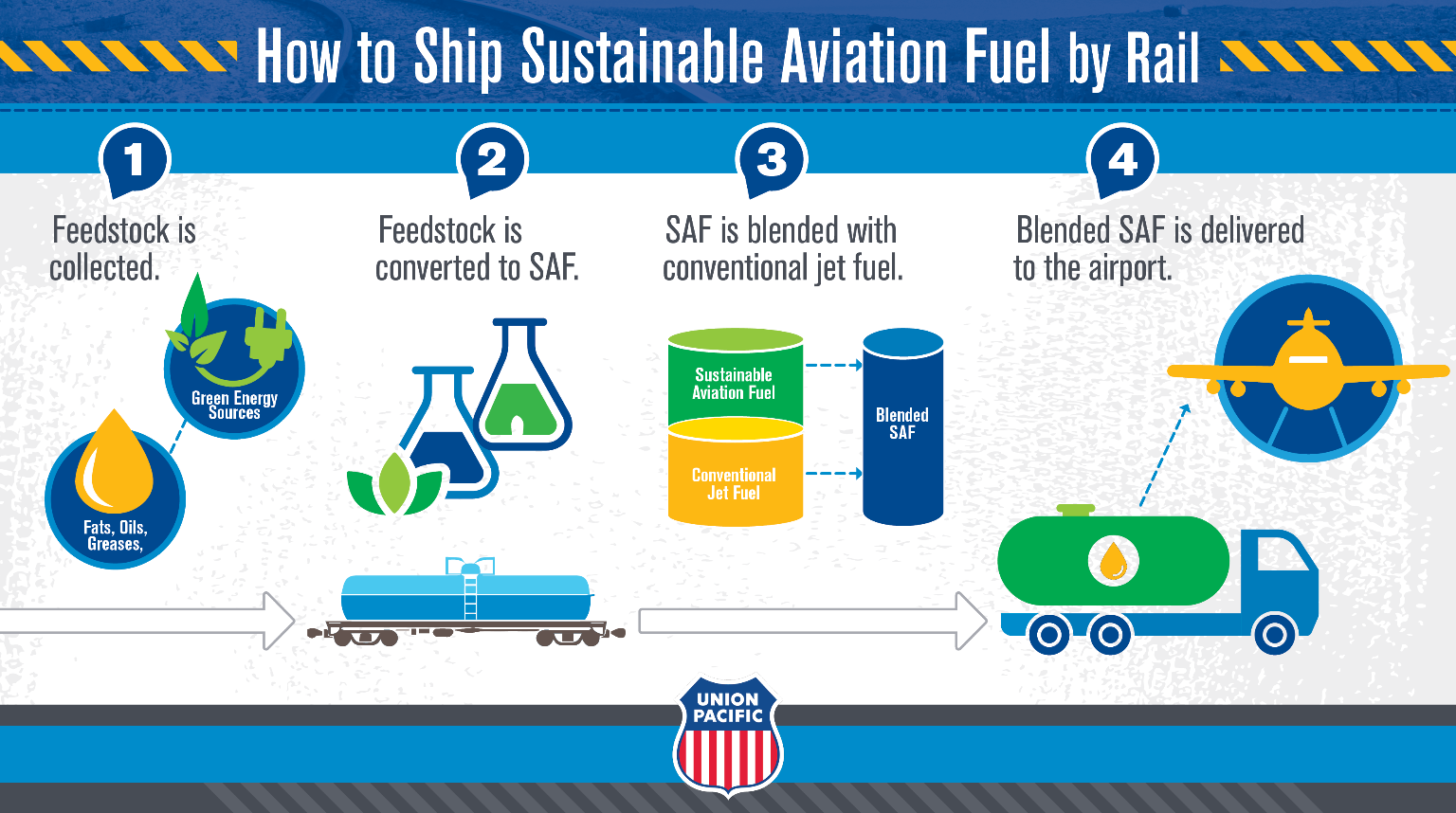
How to Ship Sustainable Aviation Fuel by Rail Without Tracks
If rail is a good fit for your SAF shipments but trains don’t service the origin and/or destination, transloading can give you access to a rail shipping solution. When SAF is transloaded, it is moved from trucks to tank cars or vice versa, allowing shippers to combine the cost and environmental advantages of rail shipping with the flexibility of over-the-road trucking for the first and/or last mile.
If you currently utilize rail for shipping or want to establish rail on a privately-owned track, learn more about connecting to Union Pacific’s network.
Learn More
If you have plans to produce SAF, rail can support your changing supply chain needs while reducing the environmental impact of your shipments. Answer a few questions and an expert will be in touch to share a sustainable solution.




